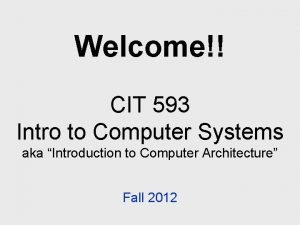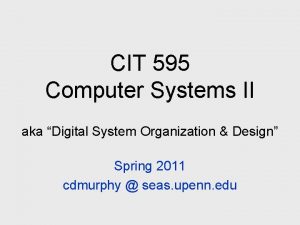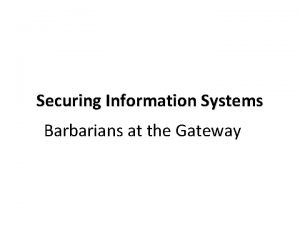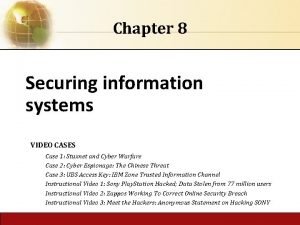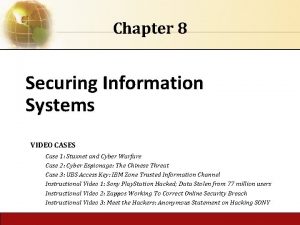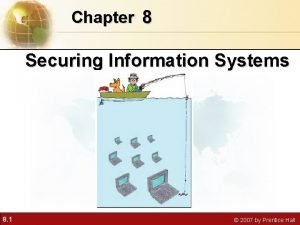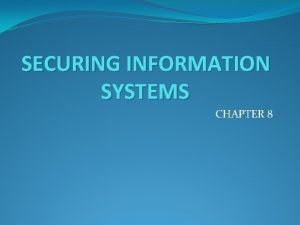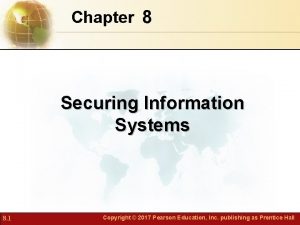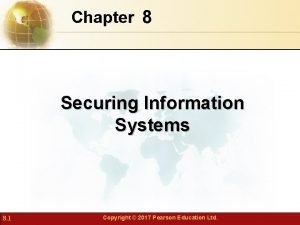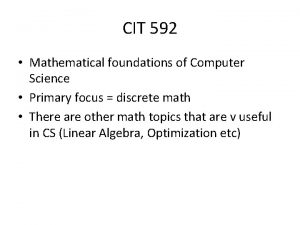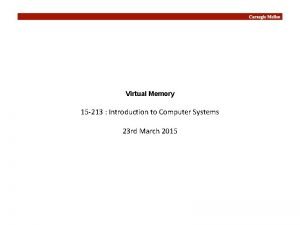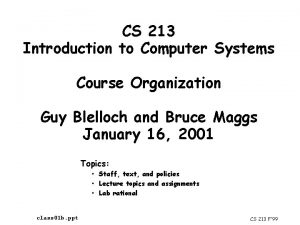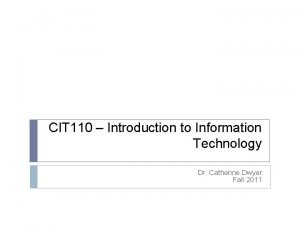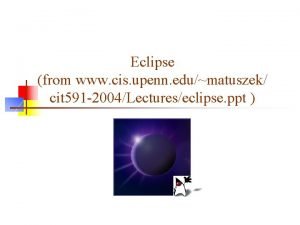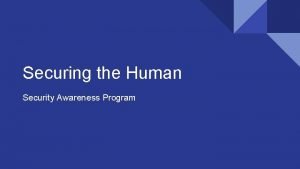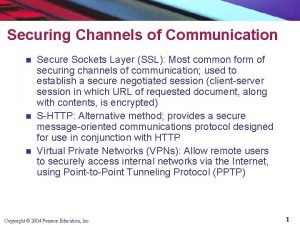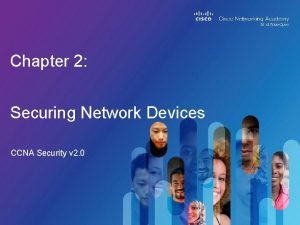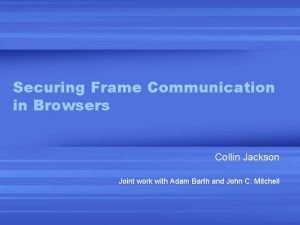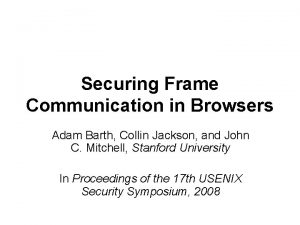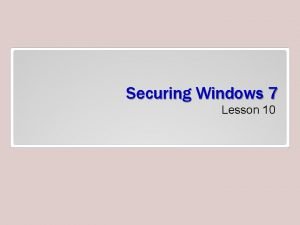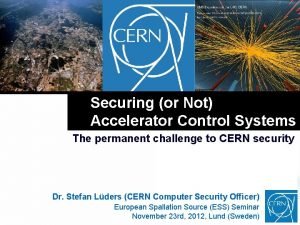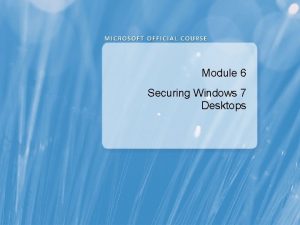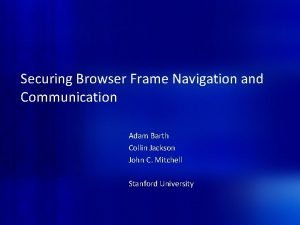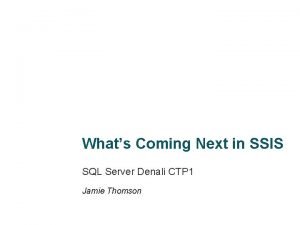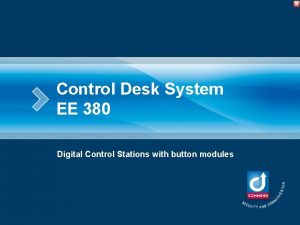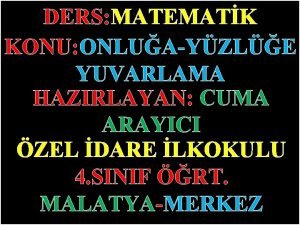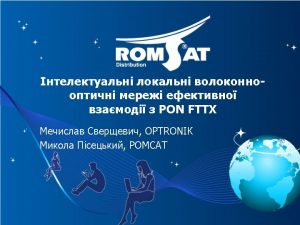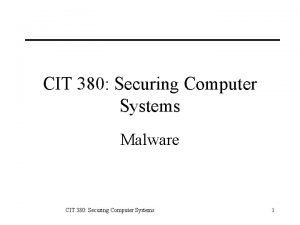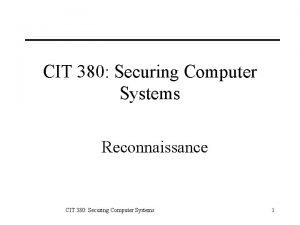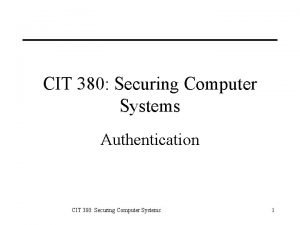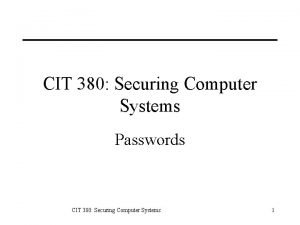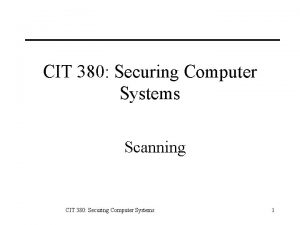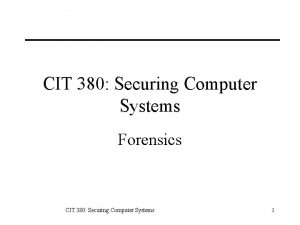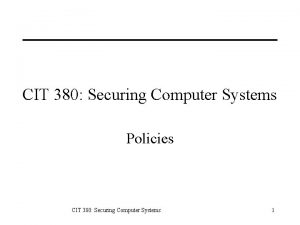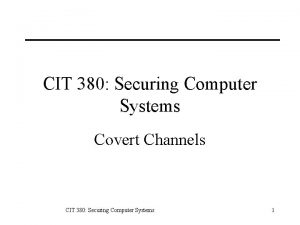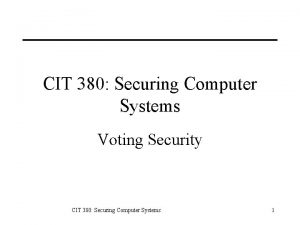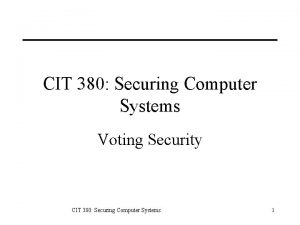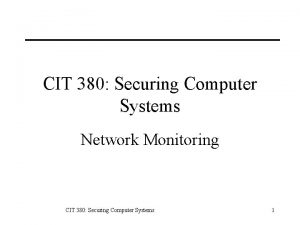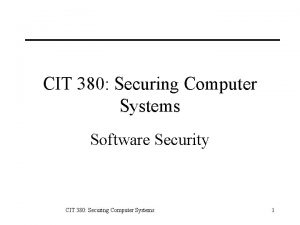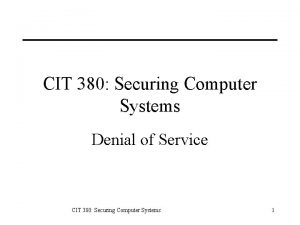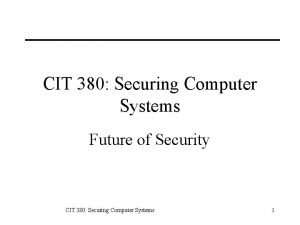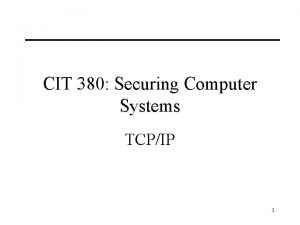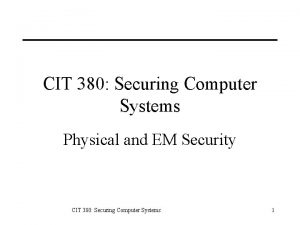CIT 380 Securing Computer Systems Introduction CIT 380

































- Slides: 33

CIT 380: Securing Computer Systems Introduction CIT 380: Securing Computer Systems 1

About Me http: //www. nku. edu/~waldenj 1 James Walden – Assistant Professor of Computer Science – waldenj@nku. edu – Interests: • • Software Security Programming Languages Software Engineering Network Security CIT 380: Securing Computer Systems 2

Course Administration Web Site – Notes, readings, and assignments on web site. – http: //www. nku. edu/~waldenj 1 Assignment submission – Use submit command on kosh. Contact Information – Email: waldenj@nku. edu – Phone: (859) 572 -5571 CIT 380: Securing Computer Systems 3

CIT 380 within the Curriculum CIT 430 Forensics CIT 140 CIT 370 CIT 380 Security CIT 484 Network Security CIT 380: Securing Computer Systems 4

Syllabus CIT 380: Securing Computer Systems 5

Course Goals 1. What is computer security? 2. How do computer systems fail? 3. How can the risks to a system be evaluated? 4. How well does a particular security solution mitigate the risks to a system? 5. How can the costs and trade-offs of a security solution be balanced? 6. What are the essential problems and solutions of network security? 7. How do viruses and worms propagate and how can they be stopped? 8. How can intrusions be detected and investigated to determine the nature of the attackand the attacker? 9. What are the ethical impacts of security technologies? CIT 380: Securing Computer Systems 6

Grading Grades are based on – Midterm Exam (30%) – Final Exam (40%) – Assignments (30%) CIT 380: Securing Computer Systems A B C D F 90 -100 80 -89 70 -79 60 -69 0 -60 7

Topics A first look at four important questions: – What is security? – How do we evaluate risks of various threats? – How does security mitigate these risks? – How do we balance the costs and trade-offs of our security solutions? CIT 380: Securing Computer Systems 8

9/11 Most devastating terrorist attack in history. – Low-tech. – Innovative. • Completely different than earlier hijackings. • We thought we had solved airplane bombings by ensuring passengers were on same flight as baggage. – What were the security responses? • How effective were the responses? • What were the costs? CIT 380: Securing Computer Systems 9

What is Security? Security is the prevention of certain types of intentional actions from occuring in a system. – These potential actions are threats. – Threats that are carried out are attacks. – Intentional attacks are carried out by an attacker. – Objects of attacks are assets. CIT 380: Securing Computer Systems 10

Safety vs Security Adversary: An intelligent attacker who intentionally causes the system to fail. Safety • Home: fire alarm. • Car: crumple zones. • Computer: UPS. Security • Home: door lock. • Car: alarm. • Computer: Login password. Safety and security can interact: Who is watching your computer room after the fire alarm was pulled? CIT 380: Securing Computer Systems 11

Goals of Security Prevention – Prevent attackers from violating security policy Detection – Detect attackers’ violation of security policy Recovery – Stop attack, assess and repair damage Survivability – Continue to function correctly even if attack succeeds CIT 380: Securing Computer Systems 12

NSTISSC Security Model CIT 380: Securing Computer Systems 13

Components of Security Confidentiality – Keeping data and resources hidden. Privacy. Integrity – Preventing unauthorized changes to data or resources. Availability – Enabling access to data and resources CIT 380: Securing Computer Systems 14

Confidentiality Authentication Passwords, mother’s maiden name Corporations Trade secrets, e. g. , the formula for Coca Cola. Databases SSN, Driver’s license Governments National security Embarrassing information: www. thememoryhole. org CIT 380: Securing Computer Systems 15

Integrity Data Integrity – content of the information. – ex: 2005 Walmart $1. 5 million bar code scam. Origin Integrity (authentication) – source of the information. – ex: 1997 Kurt Vonnegut MIT commencement address email. Vonnegut was not the 1997 speaker and the content wasn’t his. Prevention vs Detection CIT 380: Securing Computer Systems 16

Availability Prevent loss of system access. Denial of service attacks common. – Easy to launch, difficult to track down. – Can be just part of another attack CIT 380: Securing Computer Systems 17

States of Information 1. Storage Information not currently being accessed. 2. Processing Information currently being used by processor. 3. Transmission Information in transit btw one node and another. CIT 380: Securing Computer Systems 18

Security Measures Technology. – Hardware/software used to ensure confidentiality, integrity, or availability. Policy and practice. – Security requirements and activities. Education, training, and awareness. – Understanding of threats and vulnerabilities and how to protect against them. CIT 380: Securing Computer Systems 19

How to evaluate security solutions? 1. What assets are you trying to protect? 2. What are the risks to those assets? 3. How well does the security solution mitigate those risks? 4. What other risks does the security solution cause? 5. What costs and trade-offs does the security solution impose? CIT 380: Securing Computer Systems 20

Aspects of Risks To evaluate a risk, we need to evaluate both: – Probability of risk occurring. – Cost incurred by risk if it occurs. Minimize product of probability and cost. Risks are impacted by environment. – Building a house in a flood plain incurs additional risks beyond that of house itself. – Similarly, installion and configuration options impact risk of software systems. CIT 380: Securing Computer Systems 21

Security is a matter of Trade-offs Security is only one of many system goals: • • • Functionality Ease of Use Efficiency Time to market Cost Security CIT 380: Securing Computer Systems 22

Cost-Benefit Analysis Is it cheaper to prevent violation or recover? – Cost of good network security: • Money, time, reduced functionality, annoyed users. • Large and ongoing. – Risks of bad network security: • Angry customers, bad press, network downtime. • Small and temporary. CIT 380: Securing Computer Systems 23

Airport Security Let’s consider the issue of airport security again from the standpoint of what we’ve learned. Develop a solution, keeping the 5 questions in mind: 1. What assets are you trying to protect? 2. What are the risks to those assets? 3. How well does the security solution mitigate those risks? 4. What other risks does the security solution cause? 5. What costs and trade-offs does the security solution impose? CIT 380: Securing Computer Systems 24

Human Issues: People Problems Social engineering – Kevin Mitnick testified before Congress “I was so successful in that line of attack that I rarely had to resort to a technical attack. ” Circumvention – Users write down passwords, leave screens unlocked. Insider attacks CIT 380: Securing Computer Systems 25

Human Issues: Organizations Low priority – Security costs, but doesn’t produce income. – Lack of liability reduces costs of bad security. Variable impact – Cost of security violation highly variable. – Insurance converts variable risk to fixed cost, but risk too variable for much involvement so far. Power and responsibility – Personnel responsible for security often don’t have power to enforce security. CIT 380: Securing Computer Systems 26

Security: Laws and Customs Are desired security measures illegal? – cryptography export before 2000 – is it legal to monitor security breakins? – international commerce Will users circumvent them? – writing down passwords – removing file ACLs CIT 380: Securing Computer Systems 27

Security Liability Product liability: – Tires: Continental recalled Ford SUV tires in 2002 due to wire and vibration problems. – Software: Manufacturer not liable for security flaws. Since Microsoft isn’t liable for Windows security failures, why would they want to sacrifice money, time, functionality, and ease of use for security? CIT 380: Securing Computer Systems 28

Assumptions • Security rests on assumptions specific to type of security required and environment. • Example: – TCP/IP designed for pre-commercial Internet. • Assumed only legitimate admins had root access. • Trusted IP addresses, since only root can set IP addr. • What happens to network when Windows 95 systems added to network, where desktop user has all privileges? CIT 380: Securing Computer Systems 29

Assurance How much can you trust a system? Example: – Purchasing aspirin from a drugstore. – Bases for trust: • Certification of drug by FDA. • Reputation of manufacturer. • Safety seal on bottle. CIT 380: Securing Computer Systems 30

How much do you trust? Ken Thompson’s compiler hack from “Reflections on Trusting Trust. ” – Modified C compiler does two things: • If compiling a compiler, inserts the self-replicating code into the executable of the new compiler. • If compiling login, inserts code to allow a backdoor password. – After recompiling and installing old C compiler: • Source code for Trojan horse does not appear anywhere in login or C compiler. • Only method of finding Trojan is analyzing binary. CIT 380: Securing Computer Systems 31

Key Points • Components of security – Confidentiality – Integrity – Availability • States of information – Storage, Processing, Transmission • Evaluating risk and security solutions. – Security is a matter of trade-offs. • Security is a human problem. CIT 380: Securing Computer Systems 32

References 1. Ross Anderson, Security Engineering, Wiley, 2001. 2. Matt Bishop, Introduction to Computer Security, Addison-Wesley, 2005. 3. Peter Neumann, (moderator), Risks Digest, http: //catless. ncl. ac. uk/Risks/ 4. Bruce Schneier, Beyond Fear, Copernicus Books, 2003. 5. Ken Thompson, “Reflections on Trusting Trust”, Communication of the ACM, Vol. 27, No. 8, August 1984, pp. 761 -763 (http: //www. acm. org/classics/sep 95/) CIT 380: Securing Computer Systems 33
 Cit 593
Cit 593 Cit 595
Cit 595 Securing information system
Securing information system Securing information systems
Securing information systems Chapter 8 securing information systems
Chapter 8 securing information systems Chapter 8 securing information systems
Chapter 8 securing information systems Securing information systems
Securing information systems Chapter 8 securing information systems
Chapter 8 securing information systems Chapter 8 securing information systems
Chapter 8 securing information systems Cit 592
Cit 592 15-213 introduction to computer systems
15-213 introduction to computer systems 15-213 introduction to computer systems
15-213 introduction to computer systems Cit110
Cit110 Cit 591 introduction to software development
Cit 591 introduction to software development Securing the human
Securing the human The most common form of securing channels is through
The most common form of securing channels is through Defence in depth
Defence in depth Securing frame communication in browsers
Securing frame communication in browsers Adam secure browser
Adam secure browser Chapter 8 securing the republic summary
Chapter 8 securing the republic summary Securing windows 7
Securing windows 7 Securing
Securing Securing windows 7
Securing windows 7 What is draping in cosmetology
What is draping in cosmetology Securing the northwest territory
Securing the northwest territory Securing frame communication in browsers
Securing frame communication in browsers Ssis 380
Ssis 380 Ee 380
Ee 380 690-380
690-380 450 nin en yakın yüzlüğü
450 nin en yakın yüzlüğü Zodiac cadet fastroller 285
Zodiac cadet fastroller 285 380 gelir tahakkukları
380 gelir tahakkukları Ua 380
Ua 380 Nyogel 774
Nyogel 774
